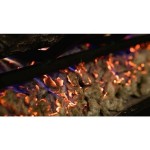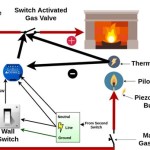Cost of a Gas Fireplace Per Hour: A Comprehensive Analysis
Gas fireplaces offer a convenient and aesthetically pleasing alternative to traditional wood-burning fireplaces. Their ease of use, clean burning properties, and consistent heat output make them a popular choice for homeowners seeking supplemental heating and ambiance. However, understanding the operational cost of a gas fireplace is crucial for effective budgeting and informed decision-making.
The cost to run a gas fireplace per hour is influenced by several factors, including the type of gas used (natural gas or propane), the efficiency of the fireplace, the local gas rates, and the heat setting employed. A thorough examination of these variables is essential to accurately estimate the operating expenses involved. This article will delve into each of these aspects, providing a detailed breakdown to help homeowners calculate their hourly cost.
Gas fireplaces are typically categorized based on their fuel source: natural gas or propane. Natural gas is generally supplied through a municipal pipeline and is often more economical than propane. Propane, on the other hand, is stored in tanks and delivered to the home. The price per unit of energy (BTU – British Thermal Unit) differs between the two, impacting the overall cost.
The efficiency rating of a gas fireplace, typically expressed as a percentage, indicates how effectively the appliance converts fuel into usable heat. A higher efficiency rating translates to less wasted energy and lower operating costs. Older models often have lower efficiency ratings compared to newer, more advanced units. This difference in efficiency can significantly affect the hourly cost of operation.
The price of natural gas or propane varies geographically and seasonally. Local utility companies or propane suppliers determine these rates, and they are usually expressed per therm (for natural gas) or per gallon (for propane). It is important to consult local providers to obtain the most accurate pricing information for the specific area of residence. These rates are often subject to market fluctuations and can change over time.
The heat setting selected on the gas fireplace directly impacts the gas consumption rate. Higher heat settings demand a greater volume of gas, resulting in a higher hourly cost. Conversely, lower heat settings consume less gas, reducing the operational expenditure. Many modern gas fireplaces offer adjustable flame heights and heat output levels, providing greater control over energy consumption.
Understanding Therms, BTU, and Gas Fireplace Consumption
To accurately calculate the cost of running a gas fireplace per hour, it is essential to understand the units of measurement involved. A therm is a unit of heat energy equivalent to 100,000 BTUs. Natural gas is typically priced per therm. BTU, or British Thermal Unit, measures the amount of energy required to raise the temperature of one pound of water by one degree Fahrenheit. Gas fireplace consumption is often specified in BTUs per hour.
The gas consumption rate of a fireplace is usually indicated on the appliance's rating plate or in the user manual. This rate, expressed in BTUs per hour, represents the amount of energy the fireplace consumes at its highest setting. For instance, a fireplace rated at 30,000 BTU per hour consumes 30,000 BTUs of energy in one hour when operating at its maximum heat output.
To convert BTUs per hour to therms per hour (for natural gas), divide the BTU rating by 100,000. For example, a 30,000 BTU per hour fireplace consumes 0.3 therms per hour (30,000 / 100,000 = 0.3). This calculation allows for the determination of the gas consumption rate in a unit corresponding to the price of natural gas.
For propane fireplaces, the consumption rate is often expressed in gallons per hour. Converting BTU consumption to gallons requires accounting for the BTU content of propane, which is approximately 91,500 BTUs per gallon. To calculate the gallons per hour, divide the BTU rating by 91,500. For example, a 30,000 BTU per hour fireplace consumes approximately 0.33 gallons of propane per hour (30,000 / 91,500 ≈ 0.33).
It is important to note that these calculations assume the fireplace is operating at its maximum heat setting. In practice, users often adjust the flame height and heat output, resulting in lower gas consumption rates. Understanding the relationship between BTU consumption, therms (or gallons), and the price of gas is critical for accurate cost estimation.
Factors Influencing the Efficiency of a Gas Fireplace
The efficiency of a gas fireplace profoundly impacts its operating cost. A more efficient fireplace utilizes a greater percentage of the fuel's energy to generate heat, minimizing waste and reducing the amount of gas required to achieve a desired temperature. Several factors contribute to the overall efficiency of a gas fireplace.
The design and construction of the firebox play a significant role in efficiency. A well-insulated firebox minimizes heat loss through the walls and flue, allowing more heat to radiate into the room. Features such as sealed combustion and direct vent systems further enhance efficiency by preventing the escape of heated air and drawing combustion air from outside the home.
The type of venting system also affects efficiency. Direct vent fireplaces are typically more efficient than natural vent fireplaces. Direct vent systems draw combustion air from outside and vent exhaust gases directly outdoors, preventing the loss of heated indoor air. Natural vent systems, on the other hand, rely on the natural buoyancy of hot gases to vent through a chimney, which can result in greater heat loss.
The age and maintenance of the gas fireplace also influence its efficiency. Older models often have lower efficiency ratings compared to newer, more advanced units. Regular maintenance, including cleaning the burner, inspecting the venting system, and ensuring proper gas pressure, is essential to maintain optimal efficiency. Neglecting maintenance can lead to reduced performance and increased gas consumption.
The presence of features such as a thermostat or programmable timer can also impact efficiency. A thermostat allows the fireplace to automatically adjust its heat output to maintain a desired temperature, preventing overheating and minimizing wasted energy. A programmable timer allows users to schedule the fireplace to turn on and off at specific times, further optimizing energy consumption.
Selecting a gas fireplace with a high-efficiency rating and ensuring proper maintenance are crucial for minimizing operating costs. Considering the design, venting system, and available features can significantly impact the overall efficiency and long-term cost-effectiveness of the appliance.
Calculating the Hourly Cost: A Step-by-Step Guide
Calculating the hourly cost of running a gas fireplace involves several steps. First, determine the gas consumption rate of the fireplace in BTUs per hour. This information can be found on the appliance's rating plate or in the user manual. For example, assume a fireplace has a consumption rate of 30,000 BTU per hour.
Next, obtain the current price of natural gas or propane from the local utility company or propane supplier. The price is typically expressed per therm for natural gas or per gallon for propane. For this example, assume the price of natural gas is $1.20 per therm.
Convert the BTU per hour consumption rate to therms per hour (if using natural gas) or gallons per hour (if using propane). For natural gas, divide the BTU rating by 100,000. In this example, 30,000 BTU per hour / 100,000 BTU per therm = 0.3 therms per hour.
Multiply the gas consumption rate in therms per hour (or gallons per hour) by the price per therm (or price per gallon). In this example, 0.3 therms per hour * $1.20 per therm = $0.36 per hour. This represents the estimated cost of running the gas fireplace at its maximum heat setting.
If the fireplace is not operating at its maximum heat setting, adjust the hourly cost accordingly. For example, if the fireplace is set to half its maximum heat output, the hourly cost would be approximately half the calculated value. This adjustment requires estimating the percentage reduction in gas consumption based on the heat setting selected.
It is important to note that this calculation provides an estimate of the hourly cost. Actual costs may vary depending on factors such as variations in gas pressure, the efficiency of the fireplace, and the accuracy of the consumption rate specified by the manufacturer. Regularly monitoring gas bills can provide valuable insights into actual consumption patterns and help refine cost estimations.
By following these steps, homeowners can gain a clearer understanding of the operating cost associated with their gas fireplace and make informed decisions regarding its use. This knowledge facilitates effective budgeting and allows for the optimization of energy consumption to minimize expenses.
In addition to the direct cost of gas consumption, it is important to consider the indirect costs associated with operating a gas fireplace. These costs may include maintenance expenses, repairs, and the initial purchase price of the appliance. While these costs are not directly related to the hourly cost of operation, they contribute to the overall cost of owning and using a gas fireplace.
Regular maintenance, such as cleaning the burner and inspecting the venting system, is essential to maintain the efficiency and safety of the gas fireplace. These maintenance tasks may require professional assistance, resulting in additional expenses. Similarly, repairs may be necessary over time to address component failures or other issues, further contributing to the overall cost of ownership.
The initial purchase price of the gas fireplace represents a significant upfront investment. Different models vary in price depending on their features, efficiency, and aesthetic design. Selecting a model that balances performance, efficiency, and cost-effectiveness is crucial for maximizing value and minimizing the total cost of ownership.
Considering both the direct and indirect costs provides a more comprehensive understanding of the financial implications of owning and operating a gas fireplace. While the hourly cost of gas consumption is a primary factor, the additional expenses associated with maintenance, repairs, and the initial purchase price should also be taken into account for a complete cost analysis.

How Much Does It Cost To Run Gas Fireplace In 2024

Fireplace Usage Cost Calculator

Gas Fireplace Cost Guide Unit Add Ons Installation More

2024 Gas Fireplace Insert Costs
.aspx?strip=all)
Yearly Cost Of Operating A Gas Fireplace Regency

How Much Does A Gas Fireplace Cost Fireplaces Direct Learning Center

How Much Does It Cost To Run Gas Fireplace In 2024

Fireplace Installation Cost 2024 Gas Wood Burning Electric

How Much Does Fireplace Repair Cost In 2024 Forbes Home

How Much Does It Cost To Run Gas A Fireplace Insert Men S Journal Home Living Handbook








